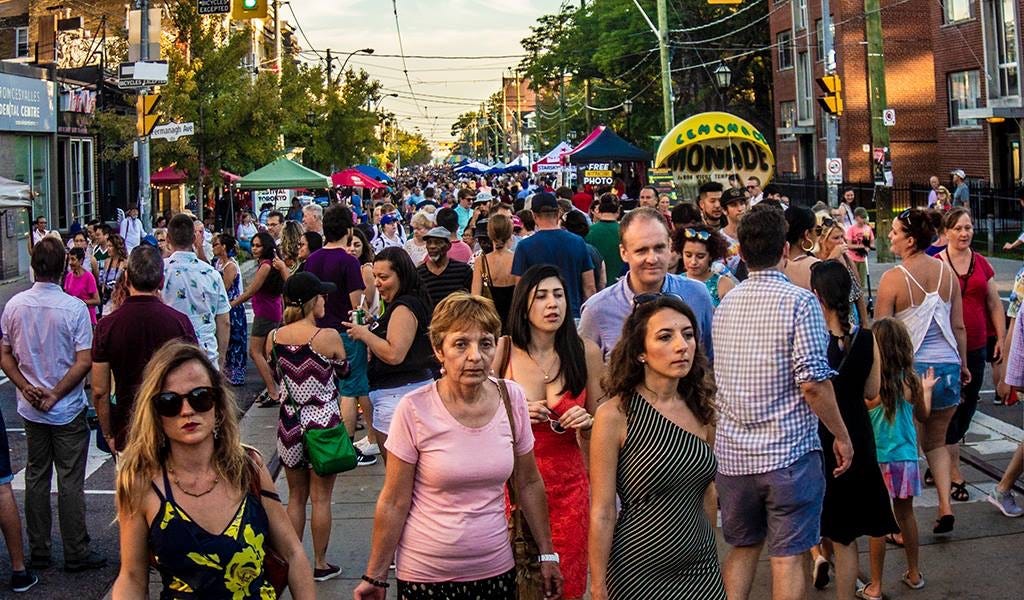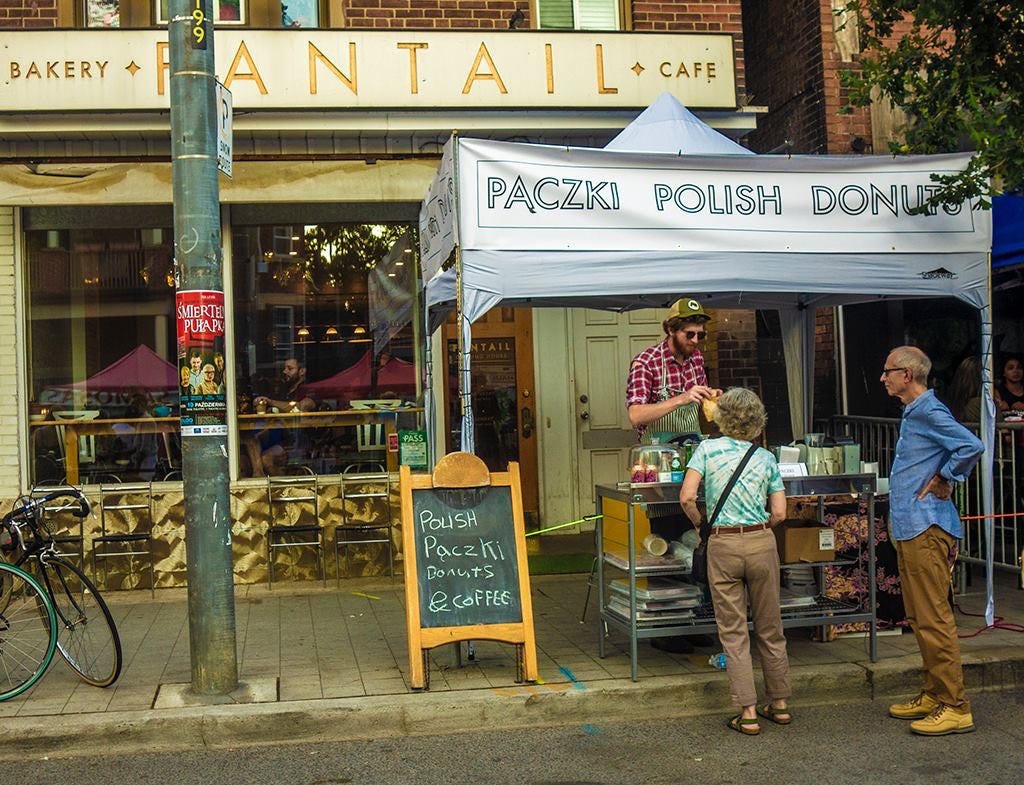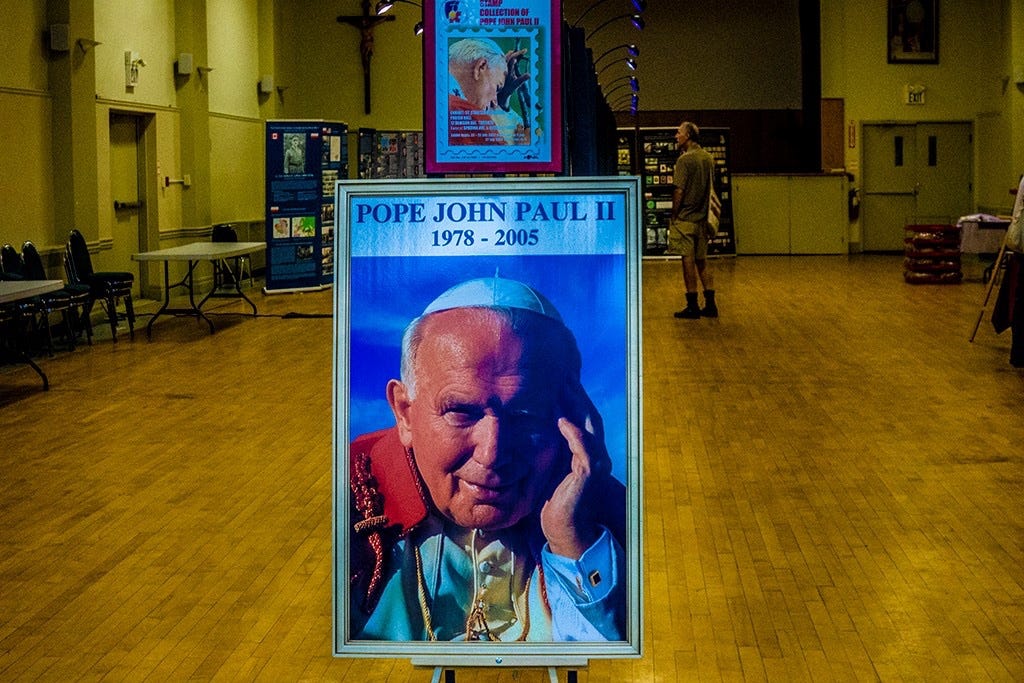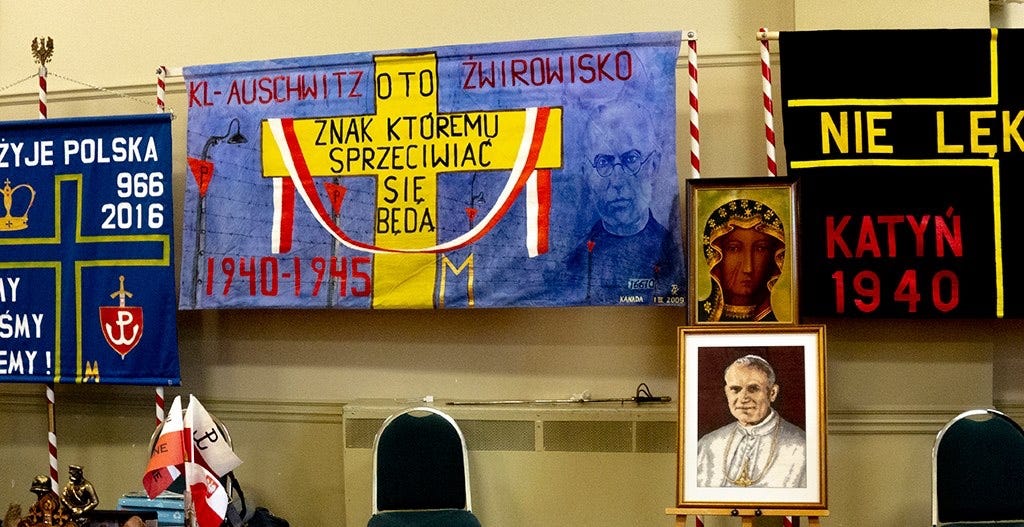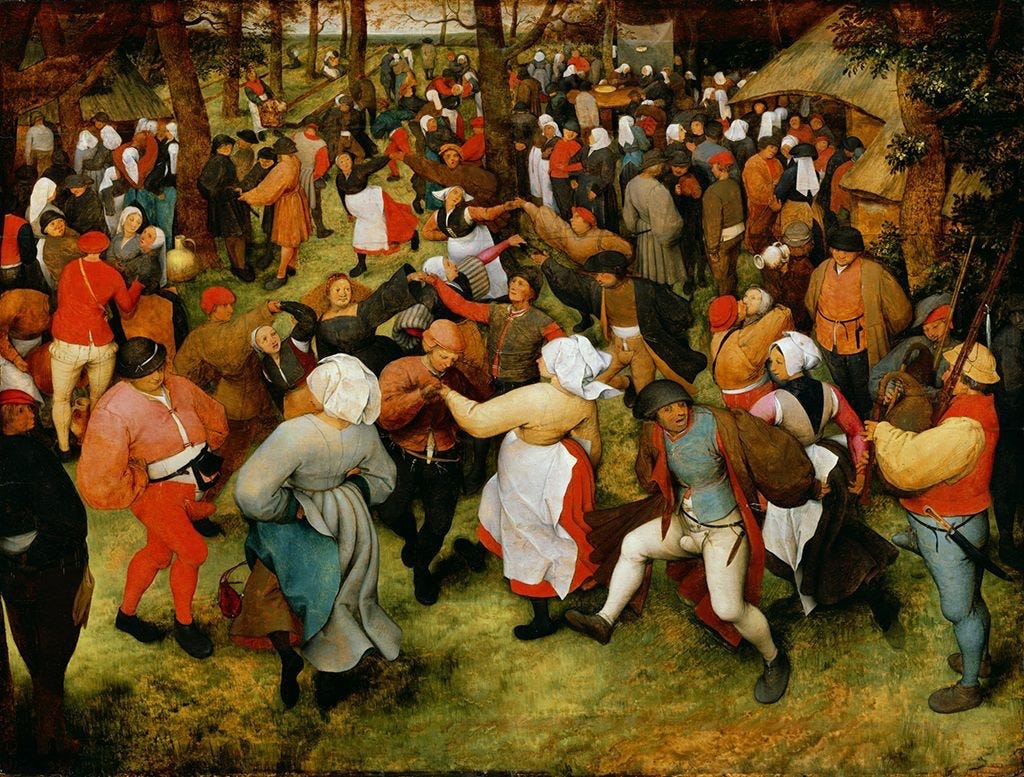I originally posted this in 2018. The issues it discusses are still relevant, notably the hollowness and willful blindness that are a big part of what we choose to call community.
I live in the Catholic parish of St. Thomas More. Though I’m Jewish by birth and a non-believer by choice, I still find this association of my neighborhood with the founder of utopia pleasing in an abstract sort of way. But utopia - in this life - is anathema to church doctrine, and had nothing to do with why More got his halo, which was rather because of his zeal in defending Catholicism and (what came down to the same thing in his day) his equal zeal in torturing and hanging Protestants. In any case I doubt most of my Catholic neighbors are familiar with More, or utopia for that matter. This is a Polish neighborhood, and if there is a real patron saint here it is the Polish Pope, John Paul II. A bronze statue of him stands outside the Catholic credit union and he surveys the local high street (Roncesvalles Avenue) with a benign smile and beatific gaze. There’s also a rumor that rubbing his toe brings good luck.
All of which is by way of introducing the following ruminations, plus photos, about an annual September ritual in my neighborhood - the Polish Festival. Two days where traffic is closed off and Roncesvalles is turned into a street fair, with booths hawking pierogies and beer, jewelry and t-shirts, cell phone contracts and banking services and lots else. Meanwhile you get serenaded by polka bands and folk dancing troupes dressed up in Polish peasant garb with garlands of plastic flowers in the girls’ hair, though you know at once without ever having set foot in the country that no Polish peasant ever dressed that well (or looked that healthy) and that you’re being served up a myth about as cheesy as the Marlboro Man.
Of course ethnic street fairs are commonplace. Italians do it, as do Ukrainians, Greeks, South Asians etc. But these days it seems to me, they have a zombie quality. Not that there’s anything wrong with eating street food, quaffing beer and listening to hokey music. And to have this event described as “North America’s Largest Celebration of Polish Culture” - well maybe Chopin is spinning in his grave but it’s innocuous stuff as far as hype goes. There’s no mystery where this comes from: you’re never more Polish (or Italian or Greek) as when you’re a million miles away, never more eager than in exile to embrace every stale symbol of ‘back home’.
But all this is underwritten by an assumption - of a thriving, or at least coherent, ethnic community. Indeed the very notion of community in this city, and most others, is bound up with ethnicity. A neighborhood is where you live, a location, but add ethnicity to that and you get a community, something you are part of. (Or you get a ghetto, which you are also part of even if you don’t want to be.) The problem is, what happens when a community loses its coherence? Does it fade away or linger as a ghostly presence?
There are still Polish people who live in the neighborhood, but far fewer than when we moved in back in 1996. It’s mostly now old folks living out their sunset years in homes they bought decades ago or at the local nursing home (named, not surprisingly, Copernicus Lodge). There used to be Polish delis every couple of blocks and a cafe called Granowska’s that was famous enough for its Polish donuts (paczki - pronounced poonshkey) that when celebrity chef Emeril Lagasse swung through town he stopped by and gushed about them with cameras rolling. There are only a couple of delis left now and Granowska’s has been replaced by a Tim Hortons, which tells you in a nutshell (or a coffee cup) what's become of this neighborhood.
Gentrification has taken its toll. For instance, my neighbors on either side of me are now university profs and neither are Polish. The neighborhood is more heterogeneous in terms of ethnicity but far more homogenous in terms of social class. Gone are not only a lot of Poles but also a lot of renters, which gave the neighborhood a different and more interesting kind of diversity because it included musicians, visual artists, actors, students and just about anybody else who wasn’t defined by being ‘well off’. But all these folks have now been ‘priced out of the market’, as they say so blithely in real estate lingo. Meanwhile the Polish kids who grew up here have mostly moved out to the suburbs. The local city councillor, when we moved in, was Polish, but that hasn’t been true for over a decade. The only ethnic Polish politician I saw campaigning at the Festival was running for city council in Mississauga. That he went to the trouble of coming so far to set up a booth meant that he expected to run into a lot of voters from his neck of the woods in the festival crowd. And the only paczki I saw for sale was at a decidedly un-Polish trendy bakery, made by a pastry chef from New Zealand.
Yet the shell of the community persists after many of the people are gone. A big part of this is because key institutions, unlike people, are set in stone. The institutional anchor of the Polish community is the church, in this case St. Casimir’s, which occupies most of a block on Roncesvalles, with a two-storey high crucifix stuck in the sidewalk outside. (Around the corner is the public elementary school my kids attended and I sometimes worried that passing this lurid image every day of a naked man writhing in pain might give them nightmares, but thankfully they were too small and having too much fun for it to make an impression.) St. Casimir’s gets a respectable turnout on Sundays and is packed on high holy days, but many of the worshippers commute in, often in bulky SUVs, those vehicular insignia of god’s grace, occupying every available street parking spot for blocks around. Once out of curiosity I went there to Midnight Mass, only to be reminded of how pagan Catholicism is (with its statuary, theatricality, priestly vestments and incense) and also how insufferably boring organized religion is. But one thing did leave an impression - the way at evening’s end the faithful all scattered in their cars in the dark of night as if they were ghosts fleeing back to their nether world before dawn, while I, progeny of Christ killers, was left alone on the sidewalk to hobble home.
***
So an exile community is now in large part in exile from itself. And yet the more that is the case, the more the community clings to a symbolic trapping like the annual street festival. It’s as if to say, This is who we still are. Except it isn’t, so it becomes an exercise in make believe.
But make believe is not nothing. Nowadays it pervades so much of life that one is almost tempted to rewrite Descartes: I make believe, therefore I am. This is most obviously true of our inner life (no Freud without fantasy) but it is increasingly, alarmingly, true of social life as well, especially of politics. In the era of Trump and the surge of right-wing populism globally, the exercise of political power becomes performance art, as it was in the heyday of fascism. Spectacle is everywhere and it saturates political discourse. The White House is now a reality tv show. Elsewhere the style differs depending on national tradition, but always the performance is pitched in the key of victimhood and paranoia - because a great many people really are victims but the ‘others’ they been convinced to blame for that are scapegoats, make believe.
In Poland the performance is steeped in national myths and Catholic ‘values’. The Law and Justice party came to power in 2015 with a clarion call to ‘get up off our knees’, their version of Make America Great Again. Poland does have a blood-soaked history, but the anger in this case was mostly directed at the ‘bullies’ of the EU who want Poland to take in a share of migrants coming to Europe and also to recognize gay rights and abortion rights. Law and Justice rejects this ‘modernity’ as yet another attempt to victimize Poland, which it portrays as the “Christ of nations.”
In power the party has combined some canny, and very popular, social welfare measures (baby bonus cheques, reducing the retirement age, new housing subsidies) with authoritarian rule - taking control of the mass media, stacking the courts with party loyalists, threatening anyone with jail terms for mentioning Polish collaboration with the Holocaust. Islamophobia is rampant (the more so since there are hardly any Muslims in the country) and anti-semitism isn’t far behind, especially outside the big cities. The funny thing about ‘getting up off our knees’ is that when you do, it’s not like you become noble and virtuous, as the traditional image of a good Christian would lead you to expect; indeed being on your knees is one of the things that makes for a good Christian. On the contrary, you want to make damn sure that someone pays for your humiliation. Your model is no longer the meek, who supposedly will inherit the earth, but the in-your-face bully who already owns it. Needless to say, the Polish government are big fans of Trump, they like him so much they even want to set up a military base in his name.
All that being said, the political contradictions in Poland are as bewildering as anywhere else. Oxfam has just ranked Poland as among the top countries in the world for fighting income inequality and child poverty. A lot of the money for that happens to come, ironically enough, from the demonized EU. This is a country where two thirds of the population still lives in small towns and on farms. The neoliberalism that earlier governments embraced alienated the rural poor, and they were eager to follow a populist message. This doesn’t make the picture any less dark, it just complicates it. In studies of everyday life in Nazi Germany, ‘ordinary’ Germans often spoke glowingly of how good life was for them, especially in the early years of the regime, before the outbreak of war. There were jobs and better housing. Fewer people went hungry and the sick had better access to treatment. Lots of Germans were able to afford vacations to places like Norway or Spain. “They Thought They Were Free” is the title of a classic study on the subject. Which goes to show that the ‘concrete’ experience of a good life can also be a kind of make believe - even sometimes the most effective kind.
***
I am standing in front of a poster-size portrait of John Paul. It is in an auditorium next door to the chapel at St. Casimir’s. The portrait is a close-up of his face, and though it’s meant to radiate saintliness, there is something disconcerting about it. For one thing, half the face is dark and the eyes are barely visible. Also he is holding up the dark side with his hand, which may be to stop from shaking due to the Parkinson’s he had in his old age. But the overall effect is of a divided soul with a blank smile who is barely managing to keep himself from keeling over. The poster fronts an exhibit of pictures about the pope, and in the back there are exhibits about Poland (example: “Chopin - Poland’s Gift to World Culture”). Along the sides are display tables, one of them is of a collection of stamps of the pope from countries around the world. There is also a coin collection, though it escapes me what the religious significance of that could be. In any case there is a quaintness to these displays in a digital age, and the fact that the men behind the tables are all gray-haired reinforces the impression. Indeed, the auditorium itself seems permeated with the mould of memories, as if stepping in from the street festival outside is like walking through a time warp. I don’t imagine that there are many happy ghosts that inhabit this place. Instead I see out washed-out faces of conformity in a place of cold walls and sour smells. Or the faces of kids, generations of them, in stiffly fitting Sunday bests fidgeting through interminable catechism lessons.
Before I’d come into the auditorium I’d seen a toddler whose face reminded me of photographs of myself at that age. This may have affected my mood, but not in happy way. If there was a resemblance it was because I too have Polish roots, but I found nothing in the festival or the auditorium that engaged them. Polish Jews like my parents were Jews first, Poles a distant second - and this was such an ingrained setup in the “Christ of nations” that I doubt anyone on either side of the divide questioned it, especially in small towns like the one my parents came from. The Jew was the perpetual outsider. When my parents settled in Montreal after the war, this was no longer supposed to be the case, for their kids at any rate. In Canada Jews could at last feel fully integrated. And yet we weren’t. It didn’t help that my brother and I were educated in English in a predominantly French speaking city. And there was the occasional ‘maudit juif’ tossed our way. This never got much beyond taunts, at worst an occasional shove, but the estrangement was still palpable. In the city of Two Solitudes, French and English, the Jews became a Third Solitude. We didn’t ‘belong’. (It didn’t help that my parents were tone deaf to any of this, and they had no interest in not being a solitude. Their attitude to most French Canadians was that they were dumb and drank too much beer. If they could have cursed in joual, they probably would have returned anti-semitic taunts with ‘maudit Quebecois’.) I escaped as soon as I was old enough to, to New York, Vancouver, eventually Toronto. Now at least the street signs spoke my language but the estrangement was still there because, I suppose, other cities can never be home in the same way as the place you grew up in. (But what happens if the place you grew up in isn't entirely a home either?) And in a further degree of estrangement I have ended up living among Poles, as if what seemed to me a practical matter of choosing a place to live was really the operating of some biblical curse I inherited from my parents and from generations before them without end.
Behind the stamp collection table were several banners, including a blue one with the word Auschwitz on it and the face of a man I didn’t recognize. This was Maximilian Kolbe, I was told. He was a Polish priest known as The Saint of Auschwitz because he volunteered to die in place of another prisoner. My first reaction was indignation. They had to be kidding. The Holocaust belonged to my guys! If you wanted a face to go on that banner, there was an ocean of Jews to choose from, including dozens of my relatives. Okay, okay, this was a church, I got that, but still … the only victim of Auschwitz that gets a banner is a priest??!! And of course because he’s a priest he gets to be a saint whereas the gassed and incinerated Jews (bless them) are languishing in hell.
I knew at once this was a stupid reaction, so I didn’t say anything. The Holocaust didn’t belong to anybody, except maybe the dead. And the Poles had plenty of their own dead, though of course they think of ‘their own’ as not including Jews. Anyway I’d had enough of Poland’s “gifts to the world” and went back outside.
***
A block away was the embronzed pope. People were hanging around nearby, mostly sitting on the steps leading up to the statue, eating festival food and chatting. There were kids there as well, with their parents, and the statue welcomed them all with open arms. Later, when looking at the pictures I’d taken at the festival, I came to realize how creepy this innocuous scene was. “The greatest responsibility for the problem of sexual abuse in the church,” states a recent essay in the NY Review of Books, “clearly lies with Pope John Paul II, who turned a blind eye to it for more than twenty years. From the mid-1980s to 2004, the church spent $2.6 billion settling lawsuits in the US, mostly paying victims to remain silent. Cases in Ireland, Australia, England, Canada and Mexico followed the same depressing pattern: victims were ignored or bullied, even as offending priests were quietly transferred to new parishes, where they often abused again.”
This isn’t news, it’s been on the public record for a long time. Still it’s quite a picture: a blind eye, victims ignored, bullied and silenced, offending priests protected and allowed to abuse again and again - and for twenty years! The saint turns out to have been a Great Enabler of Evil, though while he was alive it was hard to make out his horns in the glow of his halo. And of course the bulk of the victims were kids, like the ones hanging out by the statue. And yet Poland and its diaspora are in total denial about this. In stark contrast to many other countries, including one as deeply Catholic as Ireland, there’s been almost no public reckoning with sexual abuse by priests inside Poland, and the church there won’t disclose any information it has or discuss compensation for victims. Which is to say, the legacy of Enabling Evil is still alive in the pope’s homeland. And that legacy includes the ongoing veneration of the Great Enabler.
As for instance this statue. For Poles of course it’s an homage to a culture hero but to the rest of us it’s just ethnic kitsch, to the extent that we pay it any mind at all. Actually what it really is is a pile of shit on a plinth, and a standing insult to all the church’s victims. A lot of us know enough to know that it’s a pile of shit, and yet we act as if we don’t know this, which, as one philosopher has argued, is how ideology works these days. It’s not like in the past, when we were expected to believe the bullshit fed to us by the powers that be. Nowadays we aren’t forced to believe in much of anything, but we are expected to behave as if we believed. So by default this statue goes on holding its place of honor in the center of the neighborhood. By default - isn’t this how we experience so much of our lives?
***
But I should like to think that the spirit of Thomas More (the writer, not the saint) hasn’t gone entirely missing. Utopia doesn’t get much respect these days, but in a world that no longer lives mostly by default, I could imagine Utopia festivals taking the place of nationalist-themed ones, and it could be a lot of fun. For one thing, nobody would have to be an outsider. And the setup would be different because we could finally get rid of the market as the organizing principle, which is what these festivals always are, quaint little markets. Thomas More would have hated that: he thought gold should only be used to make chamber pots. Take the money away and we stop being buyers and sellers to each other - a bewildering thought, since we’d have to figure out some other way to relate. Make believe could be a big help here, as opposed to how it’s now used politically to dehumanize the ‘other’. But all this presupposes a different kind of community, one based on something more aspirational than real estate. Pieter Bruegel once painted a festival like that, some decades after More wrote his book. But we’re still a long way from catching up with them.




